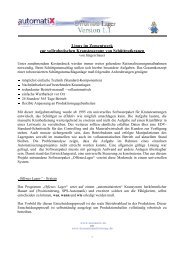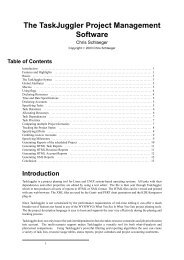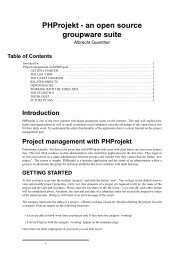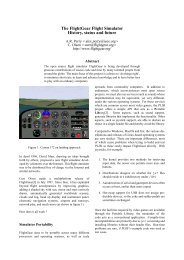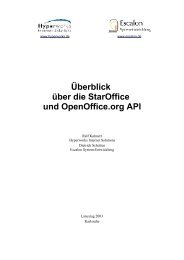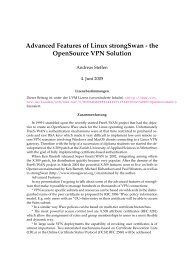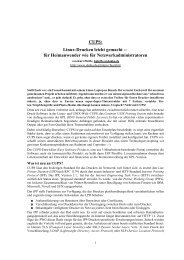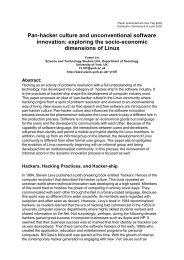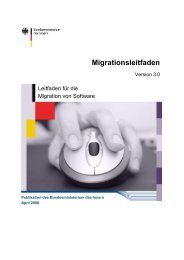You also want an ePaper? Increase the reach of your titles
YUMPU automatically turns print PDFs into web optimized ePapers that Google loves.
The vnode/vfs interface in IRIX<br />
The vnode/vfs file system interface was developed in the mid-80s to allow the UNIX kernel to support multiple<br />
file systems simultaneously. Up to that time, UNIX kernels typically supported a single file system that was<br />
bolted directly into the kernel internals. With the advent of local area networks in the mid-80s, file sharing across<br />
networks became possible, and it was necessary to allow multiple file system types to be installed into the kernel.<br />
The vnode/vfs interface separates the file-system-independent vnode from the file-system-dependent inode. This<br />
separation allows new file systems to re-use existing file-system-independent code, and, at least in theory, to be<br />
developed independently from the internal kernel data structures. IRIX and <strong>XFS</strong> use the following major structures<br />
to interface between the file system and the rest of the IRIX OS components:<br />
• vfs Virtual File System structure.<br />
• vnode Virtual node (as opposed to inode)<br />
• bhv desc behaviors are used <strong>for</strong> file system stacking<br />
• buf used as an interface to store data in memory (to and from disk)<br />
• xfs mount top-level per <strong>XFS</strong> file system structure<br />
• xfs inode top-level per <strong>XFS</strong> file structure.<br />
The vnode structure points at the first behavior in the chain of file systems handling the file associated with this<br />
vnode. The behavior also points to the function vector, xfs vnodeops, which contains all the file-system-specific<br />
routines at the file level. In IRIX, the vnodeops contains more than 57 routines which can be invoked on a "file".<br />
These routines cover many functions such as create, remove, read, write, open, close, and others.<br />
Mapping the vnode/vfs interface to <strong>Linux</strong><br />
Changing <strong>XFS</strong> to fit directly into the <strong>Linux</strong> VFS interface would require significant changes to a large portion<br />
of the <strong>XFS</strong> codebase. The current source code organization would need to be significantly changed and code<br />
charing between the IRIX and <strong>Linux</strong> versions of <strong>XFS</strong> would become much more difficult. The alternative is to<br />
integrate the vnode and vfs object as private file-system-dependent data in the struct inode and struct super block<br />
data in <strong>Linux</strong>. This approach introduces a translation layer between the <strong>XFS</strong> code and the <strong>Linux</strong> VFS interface<br />
which translate <strong>Linux</strong> VFS calls into the equivalent <strong>XFS</strong> vnode operations. The <strong>XFS</strong> vnode itself is attached to<br />
the private data area of the <strong>Linux</strong> inode, while the <strong>XFS</strong> vfs object is attached to the private data area of the <strong>Linux</strong><br />
superblock.<br />
In the initial <strong>Linux</strong> port of <strong>XFS</strong> the vnode and vfs operations remained almost unchanged from IRIX and the<br />
translation layer, called linvfs, had to do a certain amount of argument and semantics remapping. For example in<br />
IRIX the read/write entry points use the uio structures that allow to pass multiple I/O requests in one call to the<br />
filesystems while the <strong>Linux</strong> read/write entry points use a much simpler scheme with one I/O request per call. In<br />
later revisions of <strong>XFS</strong> <strong>for</strong> <strong>Linux</strong> some vnode/vfs operations where changed to fit the <strong>Linux</strong> model better. For<br />
example the lookup, create and rename VOPs now pass down the <strong>Linux</strong> dentry structure that describes a directory<br />
entry in all it’s details instead of just the name as in IRIX. This allows getting rid of superfluous internal lookup<br />
calls and access/race checks already handled in the generic <strong>Linux</strong> code. A result of these changes is that more<br />
than 2,000 lines of code that were required on IRIX could be removed from the <strong>Linux</strong> <strong>XFS</strong>.<br />
Another example are the already mentioned read/write entry points that got simplified to match their <strong>Linux</strong><br />
counterparts.<br />
fcntl Versus ioctl in IRIX and <strong>Linux</strong><br />
In IRIX, <strong>XFS</strong> supports approximately 20 special fcntl interfaces used <strong>for</strong> space pre-allocation, extent retrieval,<br />
extended file in<strong>for</strong>mation, etc. In addition, IRIX <strong>XFS</strong> has about a dozen special system call interfaces, all<br />
implemented via the special syssgi system call. These interfaces are used <strong>for</strong> operations such as growing the<br />
file system or retrieving internal file system in<strong>for</strong>mation.<br />
3





